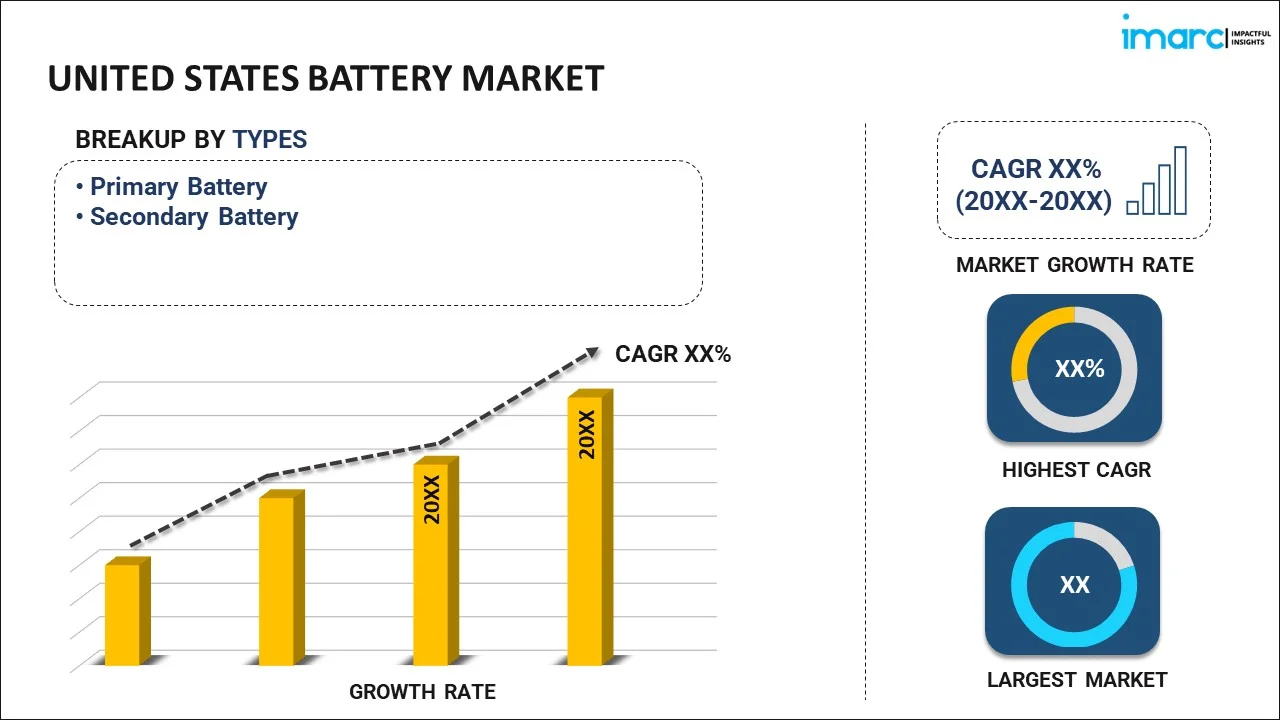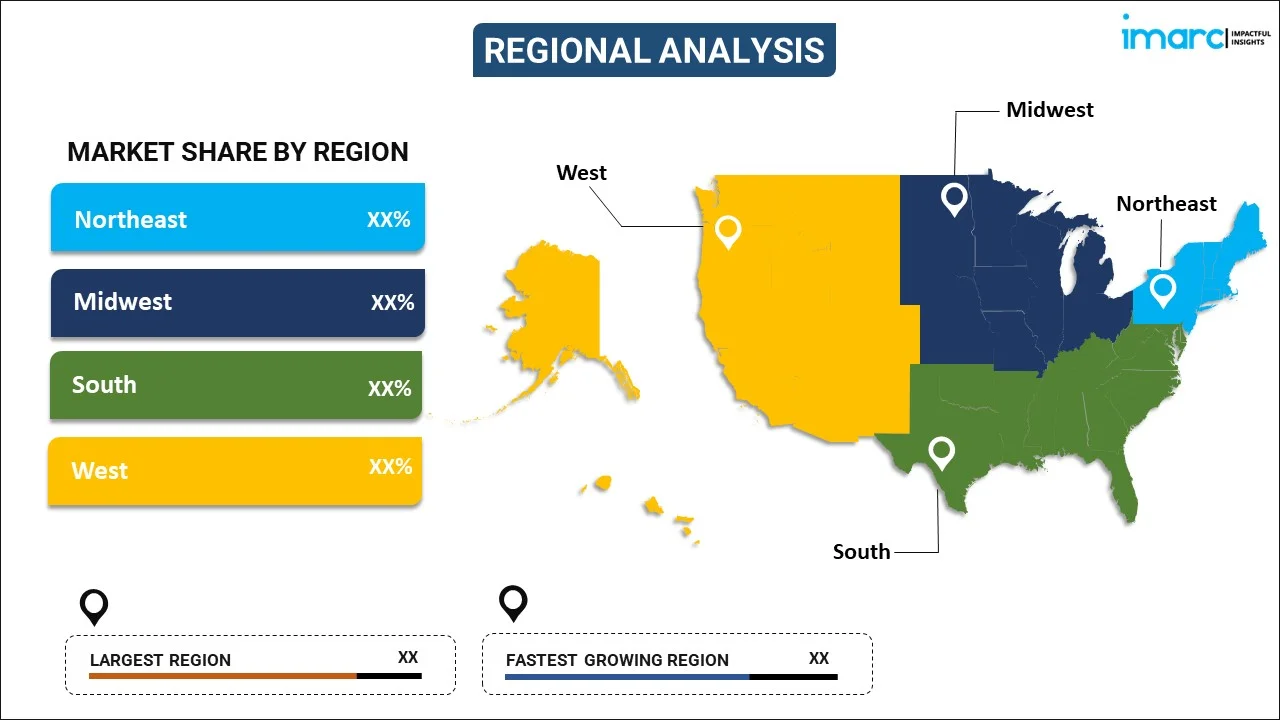
United States Battery Market Report by Type (Primary Battery, Secondary Battery), Product (Lithium-ion, Lead Acid, Nickel Metal Hydride, Nickel Cadmium, and Others), Application (Automotive Batteries, Industrial Batteries, Portable Batteries), and Region 2025-2033
Market Overview:
The United States battery market size reached USD 23.9 Billion in 2024. Looking forward, IMARC Group expects the market to reach USD 74.8 Billion by 2033, exhibiting a growth rate (CAGR) of 12.83% during 2025-2033. The rapid proliferation of electric vehicles (EV), integration of renewable energy sources, research and development (R&D) initiatives, adoption of compact and high-intensity portable batteries and the growing need for backup power solutions represent some of the key factors driving the market.
|
Report Attribute
|
Key Statistics
|
|---|---|
|
Base Year
|
2024
|
|
Forecast Years
|
2025-2033
|
|
Historical Years
|
2019-2024
|
|
Market Size in 2024
|
USD 23.9 Billion |
|
Market Forecast in 2033
|
USD 74.8 Billion |
| Market Growth Rate 2025-2033 | 12.83% |
A battery is a device that stores chemical energy and converts it into electrical energy, which can then be used to power various electronic devices. Batteries are commonly used in various applications, from portable devices like smartphones and laptops to larger systems such as cars and backup power supplies. Batteries consist of one or more electrochemical cells. Each cell contains two electrodes, an anode (negative electrode) and a cathode (positive electrode) that are separated by an electrolyte, an ion-conductive substance. The chemical reactions between the electrodes and the electrolyte allow the movement of electrons and ions, generating an electric current. Batteries come in various sizes, types, and chemistries, each with capacities, voltage, rechargeability, and lifespan characteristics. The common types of batteries include alkaline batteries, lithium-ion batteries, nickel-metal hydride (NiMH) batteries, and lead-acid batteries. The choice of battery type depends on the specific application and requirements of the powered device or system.
United States Battery Market Trends:
The rapid proliferation of electric vehicles (EVs) owing to stringent emission regulations and the push towards sustainable transportation is one of the major factors driving the market growth. In addition to this, the growing demand for advanced batteries with higher energy densities and faster charging capabilities is providing a considerable boost to the market growth. Moreover, the integration of renewable energy sources like solar and wind into the grid accentuating the need for efficient energy storage solutions to manage intermittent power generation is propelling the market growth. Batteries enable the storage of surplus energy during peak production periods and release it during high-demand intervals, contributing to grid stability and minimizing energy wastage. Additionally, the growing emphasis on research and development (R&D) to address key challenges, such as battery degradation, environmental sustainability, and cost reduction is supporting the market growth. In confluence with this, the rapid breakthroughs in materials science, including the exploration of alternative battery chemistries like solid-state batteries, that overcome battery challenges and revolutionize the energy storage landscape is favoring the market growth. Besides this, the increasing adoption of compact and high-capacity batteries due to the growing utilization of portable electronic devices, such as smartphones and wearable tech, is providing an impetus to the market growth. Furthermore, the growing need for backup power solutions in critical sectors, such as healthcare, telecommunications, and data centers driving the adoption of battery energy storage systems (BESS) for uninterrupted power supply during grid outages, is positively impacting the market growth. Apart from this, the rising collaborations between battery manufacturers and industry stakeholders to develop customized solutions for mission-critical applications is providing remunerative opportunities for market growth.
United States Battery Market Segmentation:
IMARC Group provides an analysis of the key trends in each segment of the United States battery market report, along with forecasts at the country level for 2025-2033. Our report has categorized the market based on type, product, and application.
Type Insights:

- Primary Battery
- Secondary Battery
The report has provided a detailed breakup and analysis of the market based on the type. This includes primary and secondary batteries.
Product Insights:
- Lithium-ion
- Lead Acid
- Nickel Metal Hydride
- Nickel Cadmium
- Others
The report has provided a detailed breakup and analysis of the market based on the product. This includes lithium-ion, lead acid, nickel metal hydride, nickel cadmium, and others.
Application Insights:
- Automotive Batteries
- Industrial Batteries
- Portable Batteries
A detailed breakup and analysis of the market based on the application has also been provided in the report. This includes automotive, industrial, and portable batteries.
Regional Insights:

- Northeast
- Midwest
- South
- West
The report has also provided a comprehensive analysis of all the major regional markets, which include the Northeast, Midwest, South and West.
Competitive Landscape:
The report has also provided a comprehensive analysis of the competitive landscape in the market. Competitive analysis such as market structure, key player positioning, top winning strategies, competitive dashboard, and company evaluation quadrant has been covered in the report. Also, detailed profiles of all major companies have been provided.
United States Battery Market Report Coverage:
| Report Features | Details |
|---|---|
| Base Year of the Analysis | 2024 |
| Historical Period | 2019-2024 |
| Forecast Period | 2025-2033 |
| Units | Billion USD |
| Scope of the Report | Exploration of Historical and Forecast Trends, Industry Catalysts and Challenges, Segment-Wise Historical and Predictive Market Assessment:
|
| Types Covered | Primary Battery, Secondary Battery |
| Products Covered | Lithium-ion, Lead Acid, Nickel Metal Hydride, Nickel Cadmium, Others |
| Applications Covered | Automotive Batteries, Industrial Batteries, Portable Batteries |
| Regions Covered | Northeast, Midwest, South, West |
| Customization Scope | 10% Free Customization |
| Post-Sale Analyst Support | 10-12 Weeks |
| Delivery Format | PDF and Excel through Email (We can also provide the editable version of the report in PPT/Word format on special request) |
Key Questions Answered in This Report:
- How has the United States battery market performed so far and how will it perform in the coming years?
- What has been the impact of COVID-19 on the United States battery market?
- What is the breakup of the United States battery market on the basis of type?
- What is the breakup of the United States battery market on the basis of product?
- What is the breakup of the United States battery market on the basis of application?
- What are the various stages in the value chain of the United States battery market?
- What are the key driving factors and challenges in the United States battery market?
- What is the structure of the United States battery market and who are the key players?
- What is the degree of competition in the United States battery market?
Key Benefits for Stakeholders:
- IMARC’s report offers a comprehensive quantitative analysis of various market segments, historical and current market trends, market forecasts, and dynamics of the United States battery market from 2019-2033.
- The research study provides the latest information on the market drivers, challenges, and opportunities in the United States battery market.
- Porter's five forces analysis assist stakeholders in assessing the impact of new entrants, competitive rivalry, supplier power, buyer power, and the threat of substitution. It helps stakeholders to analyze the level of competition within the United States battery industry and its attractiveness.
- Competitive landscape allows stakeholders to understand their competitive environment and provides an insight into the current positions of key players in the market.
Need more help?
- Speak to our experienced analysts for insights on the current market scenarios.
- Include additional segments and countries to customize the report as per your requirement.
- Gain an unparalleled competitive advantage in your domain by understanding how to utilize the report and positively impacting your operations and revenue.
- For further assistance, please connect with our analysts.
 Request Customization
Request Customization
 Speak to an Analyst
Speak to an Analyst
 Request Brochure
Request Brochure
 Inquire Before Buying
Inquire Before Buying




.webp)




.webp)












